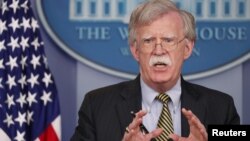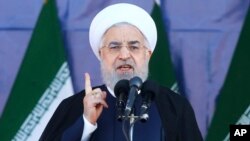The United States renewed its call to win the war on terrorism Thursday, unveiling a new counterterrorism strategy that promises to confront a complex and expanding threat by taking whatever steps are deemed necessary.
The long-awaited document, the latest in a series of updated strategies issued by the Trump administration, casts the effort to counter terrorism and terrorist groups in stark terms, with threats ranging from an adaptive and resilient Islamic State terror group to Iran.
“We are a nation at war,” the strategy proclaims. “And it is a war that the United States will win.”
“Today our country is fighting terrorist groups, such as ISIS and al-Qaida, on physical and virtual battlefields,” Homeland Security Secretary Kirstjen Nielson said in a statement about the strategy.
“Our enemies are crowd-sourcing their violence and spreading their hate to all corners of the globe, including into our own communities. And they are pursuing sophisticated plots using emerging technologies, as well as simple do-it-yourself tactics, in order to cause fear and destruction and to undermine our open society.”
While the new strategy does not get into too many details, it describes in broad strokes a more aggressive and more expansive approach.
“We recognize there is a terrorist ideology that we’re confronting,” National Security Adviser John Bolton told reporters at the White House. “It has long been the president’s view that without recognizing that we’re in an ideological struggle, we can’t properly address the terror threat.”
Bolton said the pre-eminent transnational threat to the U.S. came from “radical Islamist terrorist groups” like Islamic State and al-Qaida.
Harsh words for Iran
But he also had harsh words for Iran, calling it “the most prominent state sponsor of terrorism, really the world’s central banker of international terrorism since 1979.”
"Iran-sponsored terrorist groups such as Lebanese Hezbollah, Hamas and Palestinian Islamic Jihad continue to pose a threat to the United States and our interests," Bolton added.
Bolton said the terminology used in President Donald Trump’s counterterrorism strategy and the inclusion of Iran represents a significant shift from the previous national counterterrorism strategy.
That document, issued in 2011 under then-President Barack Obama, focused almost exclusively on al-Qaida, while downplaying the idea that the U.S. was at war with any group other than the one responsible for the Sept. 11, 2001, terror attacks on New York’s World Trade Center and the Pentagon.
"It is a departure and the reason is that it's not simply a unilateral decision by the United States to end this ideological war,” Bolton said. “It's not enough that we find it inconvenient that we're still under attack.”
New strategy
As part of the new strategy, Bolton said the U.S. will put an increased focus on terrorist networks and on disrupting the ability of terror groups to communicate, recruit, move operatives from one location to another, and on making it more difficult to finance their activities.
The strategy also emphasizes working with allies, alliances like NATO, and foreign governments, promising to “augment the capabilities of key foreign partners to conduct critical counterterrorism activities.”
But officials have been quick to point out no nation should expect a free ride.
“The strategy recognizes the need for all nations to equitably share the burden of confronting terrorism,” U.S. Secretary of State Mike Pompeo said in a statement.
Putting the strategy into effect, though, may be difficult.
Analysts caution that in some regions where the fight against terrorism has been the most critical, like Syria, Libya, Somalia and Yemen with threats like IS, al-Qaida and other groups, the U.S. has limited choices as far as potential partners.
“There are no or barely functioning governments in those areas, so how do we deal with those kinds of countries?” said Seth Jones, director of the Transnational Threats Project at the Center for Strategic and International Studies. “How do we also deal with them in cases where the governments themselves are not even an ally?”
Lofty objectives?
There are also concerns that the goals set out in the new counterterrorism strategy may be impossible to achieve.
“The objectives, especially the one of defeating terrorism, is a little lofty,” Jones said. “The idea that you’re going to defeat terrorists and that America and American soil, the homeland, will not face terrorism, that’s not realistic.”
Despite the new strategy’s heavy emphasis on Iran and terror groups like IS, it also puts a greater focus on what it describes as “a broad range of revolutionary, nationalist, and separatist movements overseas.”
It names the Nordic Resistance Movement, banned in Finland in 2017, and the neo-Nazi National Action Group, banned in Britain in 2016, as examples of groups with anti-Western views that have been seeking to broaden their appeal and engage with other like-minded organizations.
The strategy also notes a rise in domestic terrorism, whether inspired by jihadist ideology or other violent movements.
Yet for all of the changes, some veteran terrorism experts say much of what the strategy calls for should be familiar.
“With some notable exceptions here and there, this is largely a counterterrorism strategy that would have been written by any administration,” Seamus Hughes, deputy director of the George Washington University Program on Extremism, said in a tweet. “It reads like the usual interagency IC [Intelligence Community] document.”













